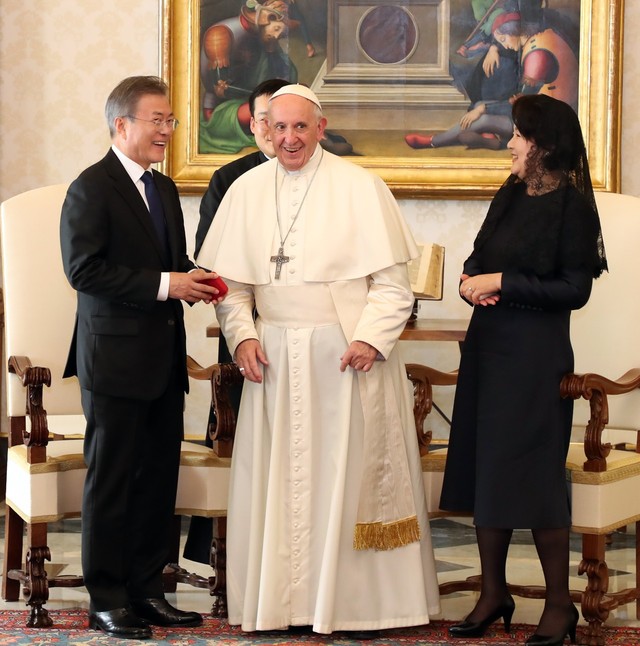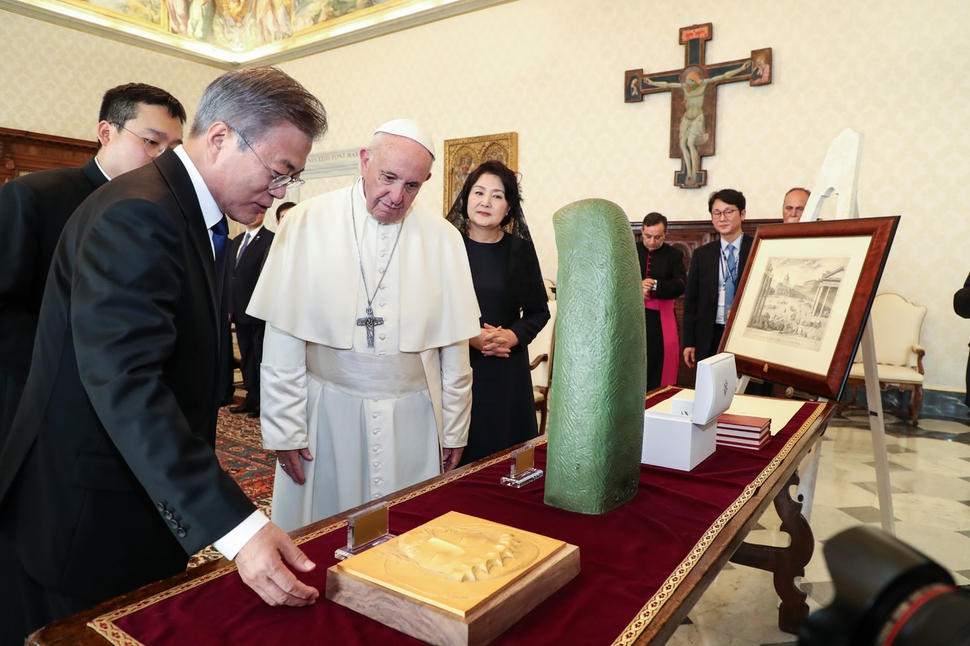 |
|
South Korean President Moon Jae-in and first lady Kim Jung-sook speak with Pope Francis at the Vatican after receiving gifts of rosaries on Oct. 18. (Blue House photo pool)
|
Many administrative and political hurdles remain in Pope Francis’ invitation to Pyongyang
“It’s a pleasure to meet you,” said Korean Christian Federation chairman Kang Myong-chol. “Peace!” replied Pope Francis, smiling brightly. The Pope’s meeting with a representative of the North Korean Christian community at a 70th anniversary event for the World Council of Churches (WCC) in Geneva on June 21 was arranged by figures from the South Korean religious community. It was Pope Francis’ first meeting with a North Korean since being named Pope in Mar. 2013. The idea of the Pope visiting Pyongyang and meeting with North Korea’s 25 million people is no longer just a dream, but something that could soon be a reality. Following his declaration in an Oct. 18 meeting with South Korean President Moon Jae-in that he would “unquestionably answer an [official] invitation” from North Korean leader Kim Jong-un and “could go” to North Korea, the questions of when and how Pope Francis might visit North Korea have become the focus of global attention. Requirements of canon law for papal visit and their potential burden on N. Korea But while the Pope’s strong commitment may have been established, many hurdles remain to be cleared for an official visit to take place. According to canon law, a formal invitation must be extended by a country’s government and Catholic church (the diocese leader for the city being visited) for the Pope to visit a specific country. If he does visit, he is to be met by the chairperson of the Catholic Bishops’ Conference of Korea and the bishop of the diocese in the city being visited – an unwritten rule that has established itself as a tradition. The individual recognized by the Vatican as (acting) bishop of the Pyongyang diocese is Archbishop Andrew Yeom Soo-jung. The administrative requirements would be met with formal invitations from Kim Jong-un and Yeom as acting bishop. Under the current state of affairs, Pope Francis would have to be met by Yeom if he visits Pyongyang. This would cause a burden for both North Korean authorities and the Vatican. Sources in the religious community said North Korea, with all its emphasis on “autonomy” and “sovereignty,” is unlikely to accept the Pope being met by the South Korean Yeom on behalf of the North Korean Catholic Church – even if the improvement in trust between the two sides after three summits this year is taken into account. North Korea has around 3,000 registered Catholics, but not a single priest The Vatican is a similarly awkward spot. North Korea has around 3,000 people registered with authorities as Catholic, but not a single priest. As a sovereign state, the Vatican City focuses on “spreading the gospel” and “guarding world peace and human rights” in its diplomacy. It’s an approach that factors into the Vatican’s lack of diplomatic ties to North Korea or socialist China and Vietnam despite relations with 183 other countries, including South Korea. In the case of China, which has around 8 million Catholics, the longstanding conflict over the appointment of bishops now stands to be resolved after the two sides signed a preliminary agreement on the matter on Sept. 22. Two Chinese bishops visited the Vatican on Oct. 16 to convey plans to invite the Pope for a visit. This explains the current hopeful predictions that a China visit by Pope Francis may be in the offing. China has not had diplomatic relations with the Vatican since severing them in 1951. Vietnam’s 6 million Catholics represent the second-highest number in Southeast Asia after the Philippines, and the country has a cardinal appointed by the Pope. Yet the Pope himself has never visited, and diplomatic ties have not been established despite long efforts by the Vietnamese government.
 |
|
South Korean President Moon Jae-in presents his gifts, a statue of the Blessed Virgin Mary and an engraving of Jesus Christ, to Pope Francis at the Vatican on Oct. 18. (Blue House photo pool)
|







